AgSAT: A Smart Irrigation Application for Field-Scale Daily Crop ET and Water Requirements Using Satellite Imagery
Abstract
1. Introduction
2. AgSAT App Conceptual Framework
2.1. Model Overview: Crop Water Requirement Based on FAO 56 Approach
2.2. General Overview of AgSAT App
2.3. AgSAT Technical Specifications
3. AgSAT ETref Performance Analyses
3.1. Direct Validation of AgSAT ETref against ETref from Various Weather Stations Worldwide
3.2. Field Validation
4. Results and Discussion
4.1. Global Validation
4.2. Field Validation
4.3. Daily and Monthly ETref Time Series Analysis
4.4. Reasons for Differences between AgSAT ETref and Station ETref
4.5. Limitations and Future Work
5. Conclusions
Author Contributions
Funding
Acknowledgments
Conflicts of Interest
Appendix A
| Crop | Equation | Reference |
|---|---|---|
| Wheat | Kcb = 1.64 × NDVI − 0.12 | [60] |
| Row vineyard | Kcb = 1.44 × NDVI − 0.1 | [61] |
| Bell pepper | Kcb = −0.12 × NDVI2 + 1.45 × NDVI − 0.06 | [37] |
| Broccoli | Kcb = −1.48 × NDVI2 + 2.64 × NDVI − 0.17 | [37] |
| Lettuce | Kcb = −0.11 × NDVI2 + 1.39 × NDVI + 0.01 | [37] |
| Corn | Kcb = 1.77 × SAVI + 0.02 | [62] |
| Potato | Kcb = 1.36 × SAVI + 0.06 | [63] |
| Sugar beet | Kcb = 1.74 × SAVI − 0.16 | [64] |
| Cotton | Kcb = 1.74 × SAVI − 0.16 | [65] |
| Garlic | Kcb = 1.82 × SAVI − 0.16 | [65] |
| Olive | Kcb = 1.59 × SAVI − 0.14 | [65] |
| Citrus | Kcb = 0.99 × SAVI − 0.09 | [65] |
| Peach | Kcb = 1.29 × SAVI − 0.12 | [65] |
| Apple trees | Kcb = 1.82 ± 0.19 × SAVI − 0.07 ± 0.06 | [66] |
| Region | Climate | Weather Stations | MAE (mm) | MBE (mm) | RE (%) | MAPE (%) |
|---|---|---|---|---|---|---|
| Africa | BSh | Monastir, Tunisia | 0.64 | −0.01 | −0.3 | 18 |
| Csa | Casablanca, Morocco | 0.62 | −0.36 | −9 | 19 | |
| BWh | Adrar, Algeria | 1.95 | −1.91 | −22 | 23 | |
| BWh | Alexandria, Egypt | 0.72 | −0.31 | -6 | 17 | |
| Asia | BWh | Rafha, Saudi Arabia | 1.43 | 1.3 | 25 | 31 |
| Csa | AREC, Lebanon | 0.51 | −0.38 | −10 | 22 | |
| BWh | Manama, Bahrain | 0.71 | −0.42 | −7 | 11 | |
| BSk | Beijing, China | 0.77 | −0.68 | −17 | 22 | |
| Csa | Kamishly, Syria | 1.2 | −1.13 | −20 | 23 | |
| BSh | Islamabad, Pakistan | 1.1 | −0.47 | −10 | 31 | |
| BWh | Mashtal, Iraq | 1.07 | 0.74 | 7 | 23 | |
| Europe | Cfb | Oak Park, Ireland | 0.47 | −0.4 | −27 | 44 |
| Cfb | Roches, Ireland | 0.35 | 0.02 | 1 | 30 | |
| Dfb | Basel, Switzerland | 0.92 | −0.87 | −32 | 47 | |
| USA and South America | Cfa | Five Points, California | 0.6 | −0.25 | −5 | 31 |
| Csa | Westlands, California | 0.64 | −0.32 | −7 | 30 | |
| Cfa | Indian River, Florida | 1.12 | 1.01 | 34 | 40 | |
| Aw | Aguas Emendadas, Brazil | 0.62 | −0.05 | −1 | 17 |
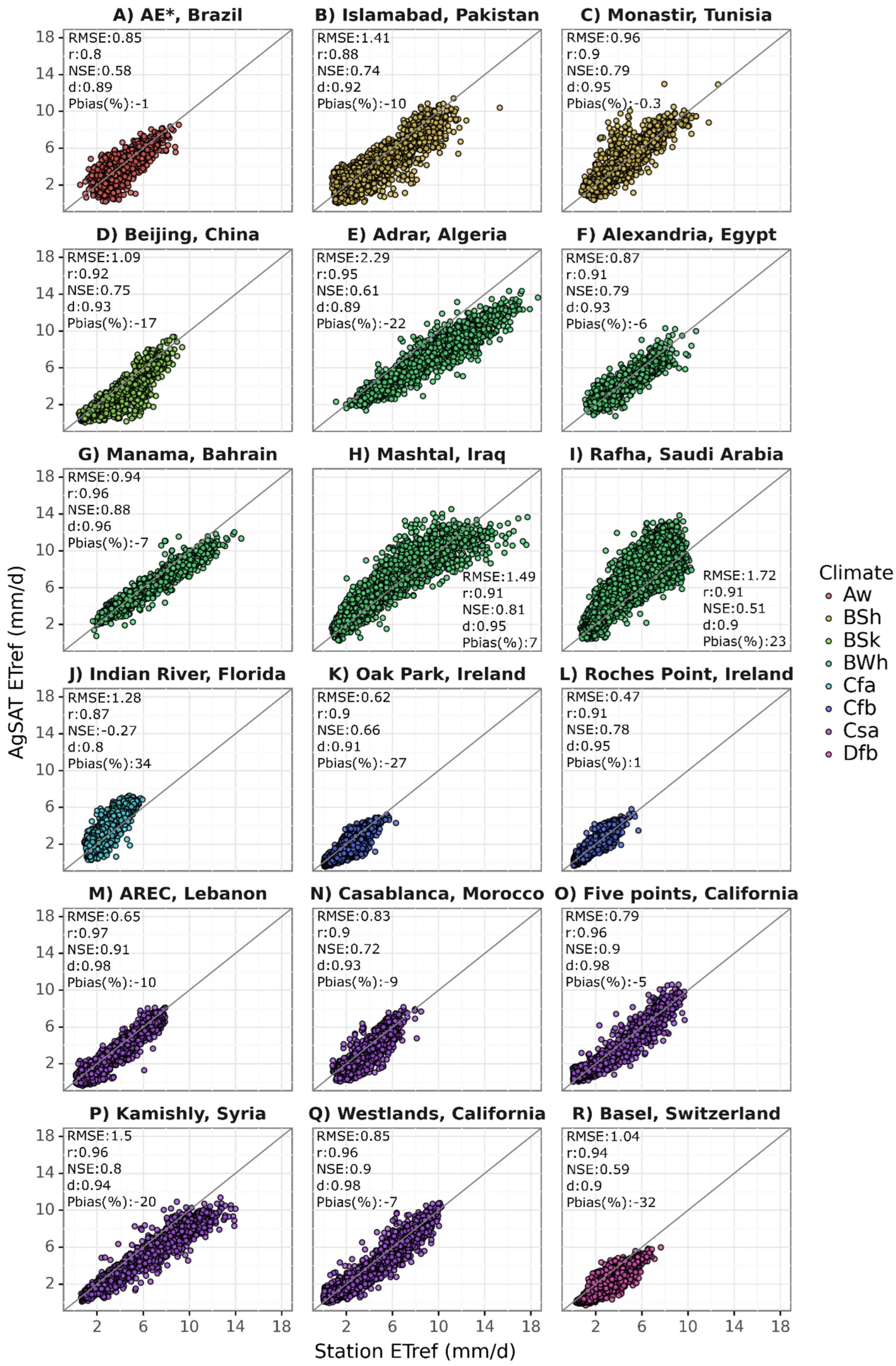

References
- Vaishali, S.; Suraj, S.; Vignesh, G.; Dhivya, S.; Udhayakumar, S. Mobile integrated smart irrigation management and monitoring system using IOT. In Proceedings of the 2017 International Conference on Communication and Signal Processing (ICCSP), Melmaruvathur, India, 6–8 April 2017; pp. 2164–2167. [Google Scholar]
- Dobbs, N.A.; Migliaccio, K.W.; Li, Y.; Dukes, M.D.; Morgan, K.T. Evaluating irrigation applied and nitrogen leached using different smart irrigation technologies on bahiagrass (Paspalumnotatum). Irrig. Sci. 2014, 32, 193–203. [Google Scholar] [CrossRef]
- Paredes, P.; D’Agostino, D.; Assif, M.; Todorovic, M.; Pereira, L.S. Assessing potato transpiration, yield and water productivity under various water regimes and planting dates using the FAO dual Kc approach. Agric. Water Manag. 2018, 195, 11–24. [Google Scholar] [CrossRef]
- Pereira, L.S.; Paredes, P.; Rodrigues, G.C.; Neves, M. Modeling malt barley water use and evapotranspiration partitioning in two contrasting rainfall years. Assessing AquaCrop and SIMDualKc models. Agric. Water Manag. 2015, 159, 239–254. [Google Scholar] [CrossRef]
- Rosa, R.D.; Paredes, P.; Rodrigues, G.C.; Fernando, R.M.; Alves, I.; Pereira, L.S.; Allen, R.G. Implementing the dual crop coefficient approach in interactive software: 2. Model testing. Agric. Water Manag. 2012, 103, 62–77. [Google Scholar] [CrossRef]
- Seidel, S.J.; Werisch, S.; Barfus, K.; Wagner, M.; Schütze, N.; Laber, H. Field evaluation of irrigation scheduling strategies using a mechanistic crop growth model. Irrig. Drain. 2016, 65, 214–223. [Google Scholar] [CrossRef]
- Zotarelli, L.; Dukes, M.; Scholberg, J.; Femminella, K.; Munoz-Carpena, R. Irrigation scheduling for green bell peppers using capacitance soil moisture sensors. J. Irrig. Drain. Eng. 2011, 137, 73–81. [Google Scholar] [CrossRef]
- Smith, M. CROPWAT: A Computer Program for Irrigation Planning and Management; Food & Agriculture Org.: Rome, Italy, 1992. [Google Scholar]
- Orange, M.; Matyac, J.S.; Snyder, R.L. Consumptive use program (CUP) model. In Proceedings of the IV International Symposium on Irrigation of Horticultural Crops 664, Davis, CA, USA, 1–6 September 2003; pp. 461–468. [Google Scholar]
- Leib, B.; Elliott, T. Washington Irrigation Scheduling Expert (WISE) Software. In Proceedings of the National Irrigation Symposium: Proceedings of the 4th Decennial Symposium, Phoenix, AZ, USA, 14–16 November 2000; pp. 14–16. [Google Scholar]
- Adeyemi, O.; Grove, I.; Peets, S.; Domun, Y.; Norton, T. Dynamic neural network modelling of soil moisture content for predictive irrigation scheduling. Sensors 2018, 18, 3408. [Google Scholar] [CrossRef] [PubMed]
- Todorovic, M.; Riezzo, E.; Buono, V.; Zippitelli, M.; Galiano, A.; Cantore, V. Hydro-Tech: An automated smart-tech Decision Support Tool for eco-efficient irrigation management. Int. Agric. Eng. J. 2016, 25, 44–56. [Google Scholar]
- Vellidis, G.; Liakos, V.; Andreis, J.; Perry, C.; Porter, W.; Barnes, E.; Morgan, K.; Fraisse, C.; Migliaccio, K. Development and assessment of a smartphone application for irrigation scheduling in cotton. Comput. Electron. Agric. 2016, 127, 249–259. [Google Scholar] [CrossRef]
- Jaafar, H.; Khraizat, Z.; Bashour, I.; Haidar, M. Determining water requirements of biblical hyssop using an ET-based drip irrigation system. Agric. Water Manag. 2017, 180, 107–117. [Google Scholar] [CrossRef]
- Bartlett, A.; Andales, A.; Arabi, M.; Bauder, T. A smartphone app to extend use of a cloud-based irrigation scheduling tool. Comput. Electron. Agric. 2015, 111, 127–130. [Google Scholar] [CrossRef]
- Sesma, J.; Molina-Martínez, J.; Cavas-Martínez, F.; Fernández-Pacheco, D. A mobile application to calculate optimum drip irrigation laterals. Agric. Water Manag. 2015, 151, 13–18. [Google Scholar] [CrossRef]
- Pulido-Calvo, I.; Montesinos, P.; Roldán, J.; Ruiz-Navarro, F. Linear regressions and neural approaches to water demand forecasting in irrigation districts with telemetry systems. Biosyst. Eng. 2007, 97, 283–293. [Google Scholar] [CrossRef]
- Perea, R.G.; García, I.F.; Arroyo, M.M.; Díaz, J.R.; Poyato, E.C.; Montesinos, P. Multiplatform application for precision irrigation scheduling in strawberries. Agric. Water Manag. 2017, 183, 194–201. [Google Scholar] [CrossRef]
- Kelley, L.; Miller, S. Irrigation Scheduling Tools; Irrigation Fact Sheet 3; Michigan State University Extension: East Lansing, MI, USA, 2011. [Google Scholar]
- Malamos, N.; Tsirogiannis, I.L.; Christofides, A.; Anastasiadis, S.; Vanino, S. Main Features and Application of a Web-based Irrigation Management Tool for the Plain of Arta. In Proceedings of the HAICTA, Kavala, Greece, 17–20 September 2015; pp. 174–185. [Google Scholar]
- Scherer, T. Web-Based Irrigation Scheduler; North Dakota State University: Fargo, ND, USA, 2014. [Google Scholar]
- Thompson, W. Irrigation Scheduling Made Simple (r): Wateright Website Does the Hard Work for You; California Grower: Vista, CA, USA, 1998. [Google Scholar]
- Cahn, M.; Smith, R.; Farrara, B.; Hartz, T.; Johnson, L.; Melton, F.; Post, K. Irrigation and nitrogen management decision support tool for vegetables and berries. In Proceedings of the US Committee on Irrigation and Drainage Conference: Groundwater Issues and Water Management—Strategies Addressing the Challenges of Sustainability USCID, Sacramento, CA, USA, 4–5 March 2014; pp. 4–7. [Google Scholar]
- Mannini, P.; Genovesi, R.; Letterio, T. IRRINET: Large scale DSS application for on-farm irrigation scheduling. Procedia Environ. Sci. 2013, 19, 823–829. [Google Scholar] [CrossRef]
- Car, N.J.; Christen, E.W.; Hornbuckle, J.W.; Moore, G.A. Using a mobile phone Short Messaging Service (SMS) for irrigation scheduling in Australia–Farmers’ participation and utility evaluation. Comput. Electron. Agric. 2012, 84, 132–143. [Google Scholar] [CrossRef]
- Deumier, J.; Leroy, P.; Peyremorte, P. Tools for Improving Management of Irrigated Agricultural Crop Systems; Water Reports; FAO: Rome, Italy, 1996. [Google Scholar]
- Montoro, A.; López-Fuster, P.; Fereres, E. Improving on-farm water management through an irrigation scheduling service. Irrig. Sci. 2011, 29, 311–319. [Google Scholar] [CrossRef]
- Levidow, L.; Zaccaria, D.; Maia, R.; Vivas, E.; Todorovic, M.; Scardigno, A. Improving water-efficient irrigation: Prospects and difficulties of innovative practices. Agric. Water Manag. 2014, 146, 84–94. [Google Scholar] [CrossRef]
- Barnes, A.; Soto, I.; Eory, V.; Beck, B.; Balafoutis, A.; Sánchez, B.; Vangeyte, J.; Fountas, S.; van der Wal, T.; Gómez-Barbero, M. Influencing factors and incentives on the intention to adopt precision agricultural technologies within arable farming systems. Environ. Sci. Policy 2018, 93, 66–74. [Google Scholar] [CrossRef]
- Barnes, A.; Soto, I.; Eory, V.; Beck, B.; Balafoutis, A.; Sánchez, B.; Vangeyte, J.; Fountas, S.; van der Wal, T.; Gómez-Barbero, M. Exploring the adoption of precision agricultural technologies: A cross regional study of EU farmers. Land Use Policy 2019, 80, 163–174. [Google Scholar] [CrossRef]
- Watcharaanantapong, P.; Roberts, R.K.; Lambert, D.M.; Larson, J.A.; Velandia, M.; English, B.C.; Rejesus, R.M.; Wang, C. Timing of precision agriculture technology adoption in US cotton production. Precis. Agric. 2014, 15, 427–446. [Google Scholar] [CrossRef]
- Ayankojo, I.T.; Morgan, K.T.; Ozores-Hampton, M.; Migliaccio, K.W. Effects of Real-time Location-specific Drip Irrigation Scheduling on Water Use, Plant Growth, Nutrient Accumulation, and Yield of Florida Fresh-market Tomato. HortScience 2018, 53, 1372–1378. [Google Scholar] [CrossRef]
- Kadyampakeni, D.M.; Morgan, K.T.; Zekri, M.; Ferrarezi, R.; Schumann, A.; Obreza, T. Citrus Irrigation Management. EDIS 2017, 2017, 1–6. [Google Scholar] [CrossRef]
- Júnior, W.M.; Valeriano, T.T.B.; de Souza Rolim, G. EVAPO: A smartphone application to estimate potential evapotranspiration using cloud gridded meteorological data from NASA-POWER system. Comput. Electron. Agric. 2019, 156, 187–192. [Google Scholar]
- Allen, R.G.; Pereira, L.S.; Raes, D.; Smith, M. Crop Evapotranspiration-Guidelines for Computing Crop Water Requirements-FAO Irrigation and Drainage Paper 56; Food and Agriculture Organization of the United Nations: Rome, Italy, 1998; Volume 56, p. e156. [Google Scholar]
- Allen, R.; Walter, I.; Elliott, R.; Howell, T.; Itenfisu, D.; Jensen, M.; Snyder, R. The ASCE Standardized Reference Evapotranspiration Equation, American Society of Civil Engineers. In Microclimate: The Biological Environment; John Wiley & Sons: Hoboken, NJ, USA, 2005. [Google Scholar]
- Johnson, L.F.; Trout, T.J. Satellite NDVI assisted monitoring of vegetable crop evapotranspiration in California’s San Joaquin Valley. Remote Sens. 2012, 4, 439–455. [Google Scholar] [CrossRef]
- Kamble, B.; Kilic, A.; Hubbard, K. Estimating crop coefficients using remote sensing-based vegetation index. Remote Sens. 2013, 5, 1588–1602. [Google Scholar] [CrossRef]
- Oliveira, T.C.D.; Ferreira, E.; Dantas, A.A.A. Temporal variation of normalized difference vegetation index (NDVI) and calculation of the crop coefficient (Kc) from NDVI in areas cultivated with irrigated soybean. Ciência Rural 2016, 46, 1683–1688. [Google Scholar] [CrossRef][Green Version]
- French, A.N.; Hunsaker, D.J.; Sanchez, C.A.; Saber, M.; Gonzalez, J.R.; Anderson, R. Satellite-based NDVI crop coefficients and evapotranspiration with eddy covariance validation for multiple durum wheat fields in the US Southwest. Agric. Water Manag. 2020, 239, 106266. [Google Scholar] [CrossRef]
- Rawat, K.S.; Singh, S.K.; Bala, A.; Szabó, S. Estimation of crop evapotranspiration through spatial distributed crop coefficient in a semi-arid environment. Agric. Water Manag. 2019, 213, 922–933. [Google Scholar] [CrossRef]
- Reyes-González, A.; Kjaersgaard, J.; Trooien, T.; Hay, C.; Ahiablame, L. Estimation of crop evapotranspiration using satellite remote sensing-based vegetation index. Adv. Meteorol. 2018, 2018, 4525021. [Google Scholar] [CrossRef]
- Zhang, Y.; Han, W.; Niu, X.; Li, G. Maize Crop Coefficient Estimated from UAV-Measured Multispectral Vegetation Indices. Sensors 2019, 19, 5250. [Google Scholar] [CrossRef] [PubMed]
- Melton, F.S.; Johnson, L.F.; Lund, C.P.; Pierce, L.L.; Michaelis, A.R.; Hiatt, S.H.; Guzman, A.; Adhikari, D.D.; Purdy, A.J.; Rosevelt, C. Satellite irrigation management support with the terrestrial observation and prediction system: A framework for integration of satellite and surface observations to support improvements in agricultural water resource management. IEEE J. Sel. Top. Appl. Earth Obs. Remote Sens. 2012, 5, 1709–1721. [Google Scholar] [CrossRef]
- Allen, R.G.; Pereira, L.S. Estimating crop coefficients from fraction of ground cover and height. Irrig. Sci. 2009, 28, 17–34. [Google Scholar] [CrossRef]
- Hoffman, G.J.; Evans, R.G.; Jensen, M.E.; Martin, D.L.; Elliott, R.L. Design and Operation of Farm Irrigation Systems; American Society of Agricultural and Biological Engineers: St. Joseph, MI, USA, 2007. [Google Scholar]
- Jaafar, H.H.; Ahmad, F.A. Time series trends of Landsat-based ET using automated calibration in METRIC and SEBAL: The Bekaa Valley, Lebanon. Remote Sens. Environ. 2020, 238, 111034. [Google Scholar] [CrossRef]
- Walter, I.A.; Allen, R.G.; Elliott, R.; Itenfisu, D.; Brown, P.; Jensen, M.E.; Mecham, B.; Howell, T.A.; Snyder, R.; Eching, S. Task Committee on Standardization of Reference Evapotranspiration; ASCE: Reston, VA, USA, 2005. [Google Scholar]
- Gao, W. Applications of solutions to non-linear energy budget equations. Agric. For. Meteorol. 1988, 43, 121–145. [Google Scholar]
- Grignon, F. A discussion of the Penman form equations and comparisons of some equations to estimate latent energy flux density. Agric. For. Meteorol. 1992, 57, 297–304. [Google Scholar]
- Cosgrove, B.A.; Lohmann, D.; Mitchell, K.E.; Houser, P.R.; Wood, E.F.; Schaake, J.C.; Robock, A.; Marshall, C.; Sheffield, J.; Duan, Q. Real-time and retrospective forcing in the North American Land Data Assimilation System (NLDAS) project. J. Geophys. Res. Atmos. 2003, 108, 8842. [Google Scholar] [CrossRef]
- Hupet, F.; Vanclooster, M. Effect of the sampling frequency of meteorological variables on the estimation of the reference evapotranspiration. J. Hydrol. 2001, 243, 192–204. [Google Scholar] [CrossRef]
- Allen, R.G.; Pereira, L.S.; Howell, T.A.; Jensen, M.E. Evapotranspiration information reporting: I. Factors governing measurement accuracy. Agric. Water Manag. 2011, 98, 899–920. [Google Scholar] [CrossRef]
- Blatchford, M.L.; Mannaerts, C.M.; Zeng, Y.; Nouri, H.; Karimi, P. Status of accuracy in remotely sensed and in-situ agricultural water productivity estimates: A review. Remote Sens. Environ. 2019, 234, 111413. [Google Scholar] [CrossRef]
- White, J.W.; Hoogenboom, G.; Stackhouse, P.W., Jr.; Hoell, J.M. Evaluation of NASA satellite-and assimilation model-derived long-term daily temperature data over the continental US. Agric. For. Meteorol. 2008, 148, 1574–1584. [Google Scholar] [CrossRef]
- Blankenau, P.A. Bias and Other Error in Gridded Weather Data Sets and Their Impacts on Estimating Reference Evapotranspiration. Master’s Thesis, University of Nebraska-Lincoln, Lincoln, NE, USA, 2017. [Google Scholar]
- Kishore, P.; Jyothi, S.; Basha, G.; Rao, S.; Rajeevan, M.; Velicogna, I.; Sutterley, T.C. Precipitation climatology over India: Validation with observations and reanalysis datasets and spatial trends. Clim. Dyn. 2016, 46, 541–556. [Google Scholar] [CrossRef]
- Allen, R.; Dhungel, R.; Dhungara, B.; Huntington, J.; Kilic, A.; Morton, C. Conditioning point and gridded weather data under aridity conditions during calculation of reference evapotranspiration. Agric. Water Manag. 2020; submitted. [Google Scholar]
- Jaafar, H.H.; Ahmad, F. Determining Reference Evapotranspiration in Greenhouses from External Climate. J. Irrig. Drain. Eng. 2019, 145, 04019018. [Google Scholar] [CrossRef]
- Duchemin, B.; Hadria, R.; Erraki, S.; Boulet, G.; Maisongrande, P.; Chehbouni, A.; Escadafal, R.; Ezzahar, J.; Hoedjes, J.; Kharrou, M. Monitoring wheat phenology and irrigation in Central Morocco: On the use of relationships between evapotranspiration, crops coefficients, leaf area index and remotely-sensed vegetation indices. Agric. Water Manag. 2006, 79, 1–27. [Google Scholar] [CrossRef]
- Campos, I.; Neale, C.M.; Calera, A.; Balbontín, C.; González-Piqueras, J. Assessing satellite-based basal crop coefficients for irrigated grapes (Vitis vinifera L.). Agric. Water Manag. 2010, 98, 45–54. [Google Scholar] [CrossRef]
- Bausch, W.C. Soil background effects on reflectance-based crop coefficients for corn. Remote Sens. Environ. 1993, 46, 213–222. [Google Scholar] [CrossRef]
- Jayanthi, H.; Neale, C.M.; Wright, J.L. Development and validation of canopy reflectance-based crop coefficient for potato. Agric. Water Manag. 2007, 88, 235–246. [Google Scholar] [CrossRef]
- González-Dugo, M.; Mateos, L. Spectral vegetation indices for benchmarking water productivity of irrigated cotton and sugarbeet crops. Agric. Water Manag. 2008, 95, 48–58. [Google Scholar] [CrossRef]
- Mateos, L.; González-Dugo, M.; Testi, L.; Villalobos, F. Monitoring evapotranspiration of irrigated crops using crop coefficients derived from time series of satellite images. I. Method validation. Agric. Water Manag. 2013, 125, 81–91. [Google Scholar] [CrossRef]
- Odi-Lara, M.; Campos, I.; Neale, C.M.; Ortega-Farías, S.; Poblete-Echeverría, C.; Balbontín, C.; Calera, A. Estimating evapotranspiration of an apple orchard using a remote sensing-based soil water balance. Remote Sens. 2016, 8, 253. [Google Scholar] [CrossRef]
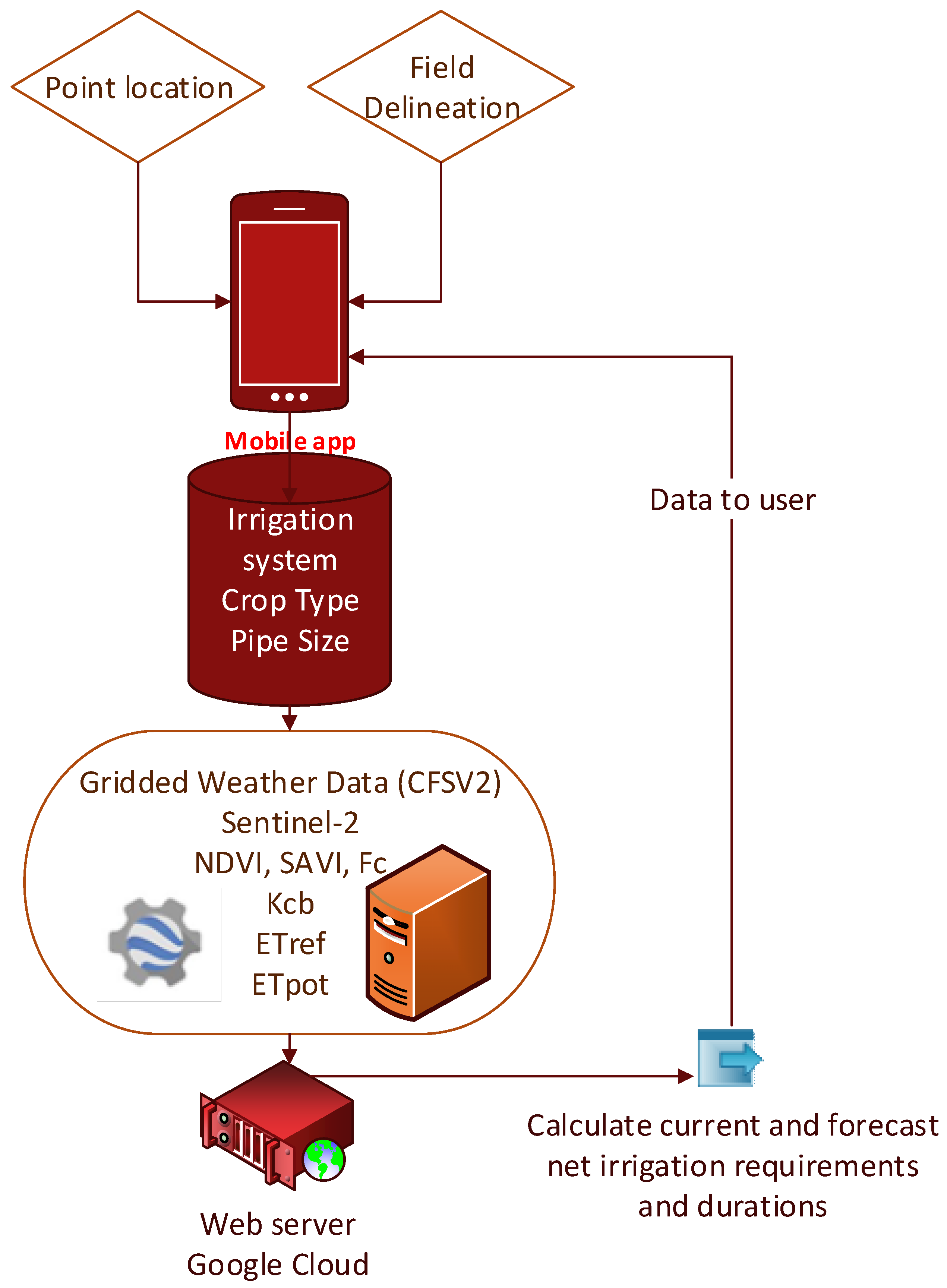
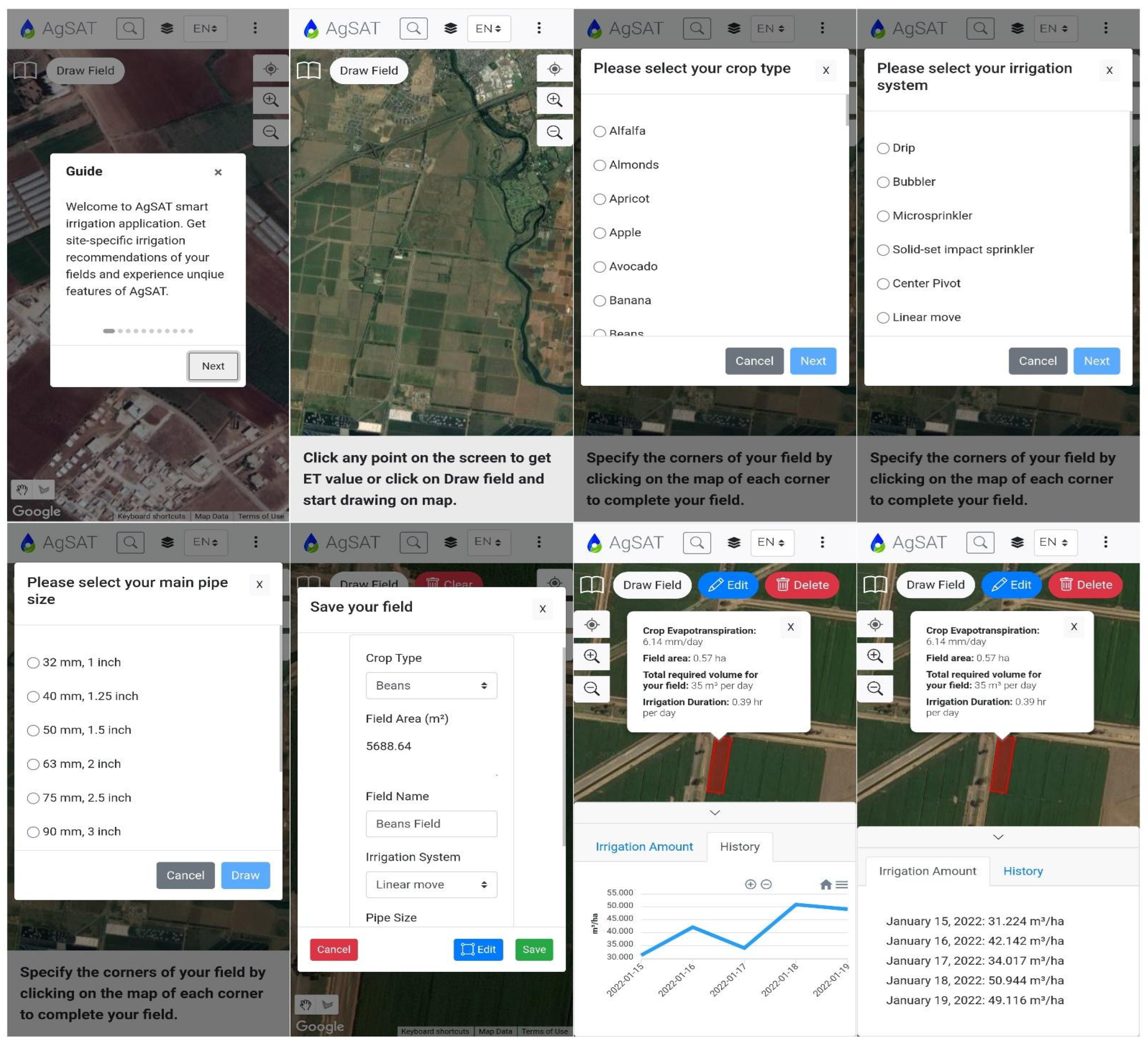
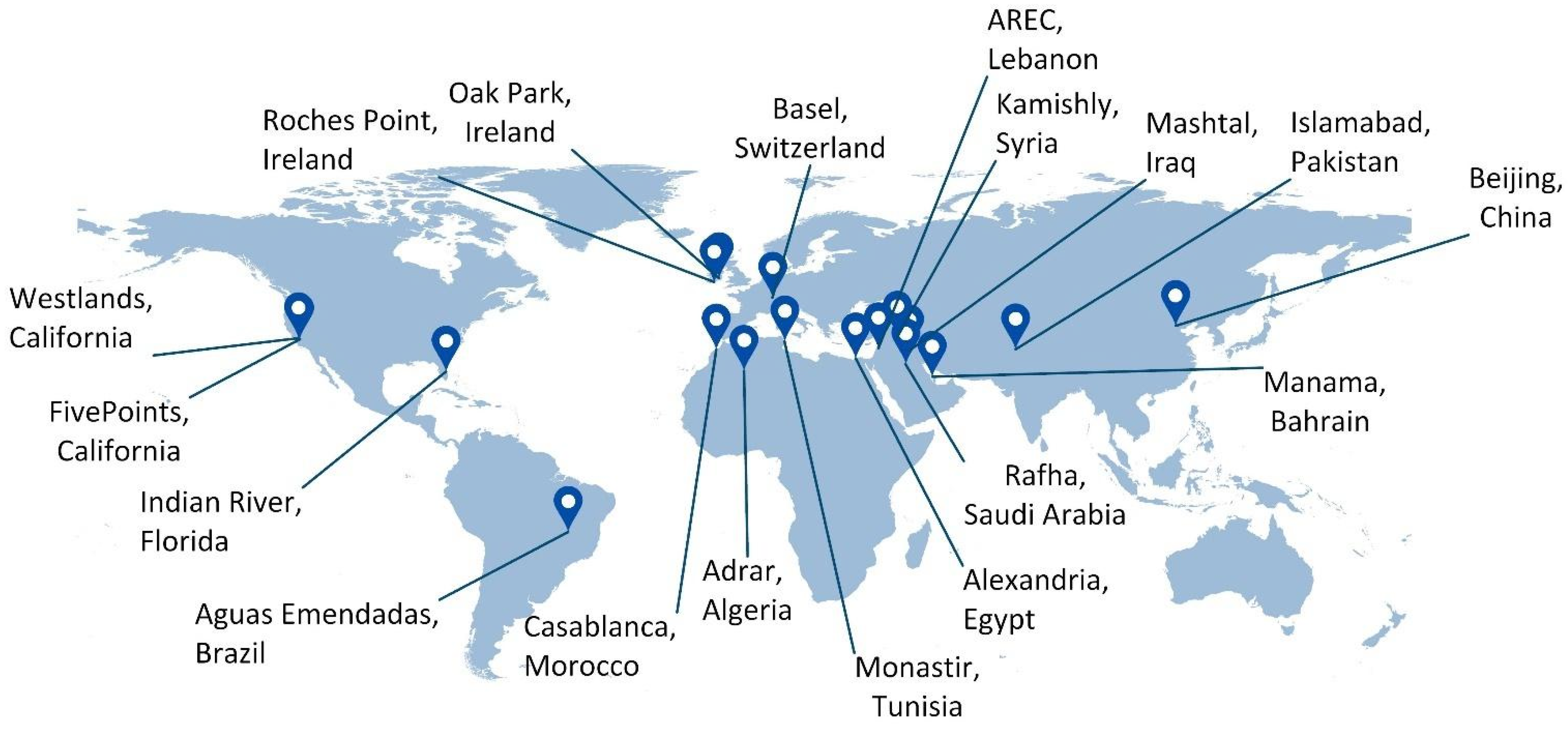
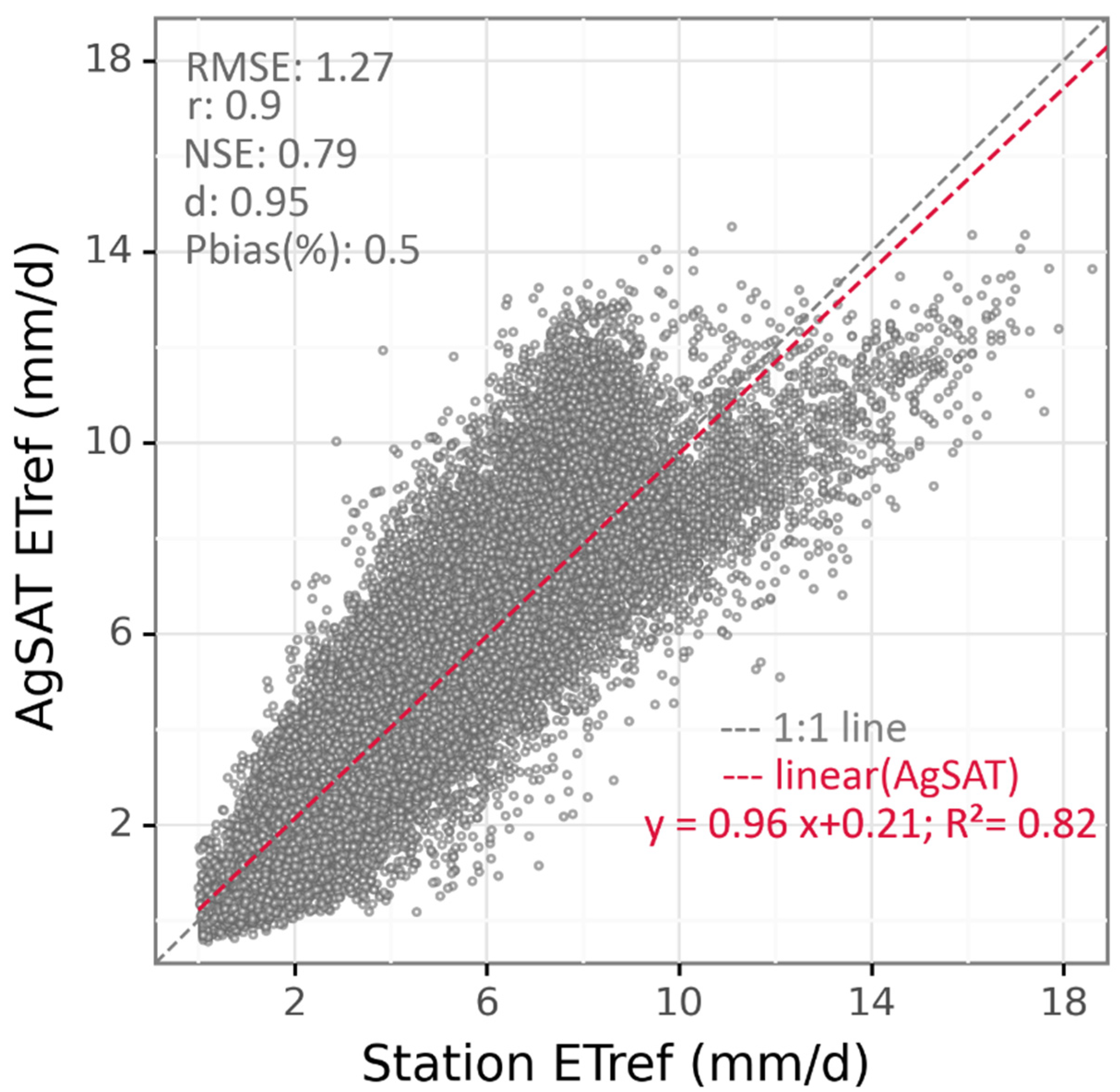
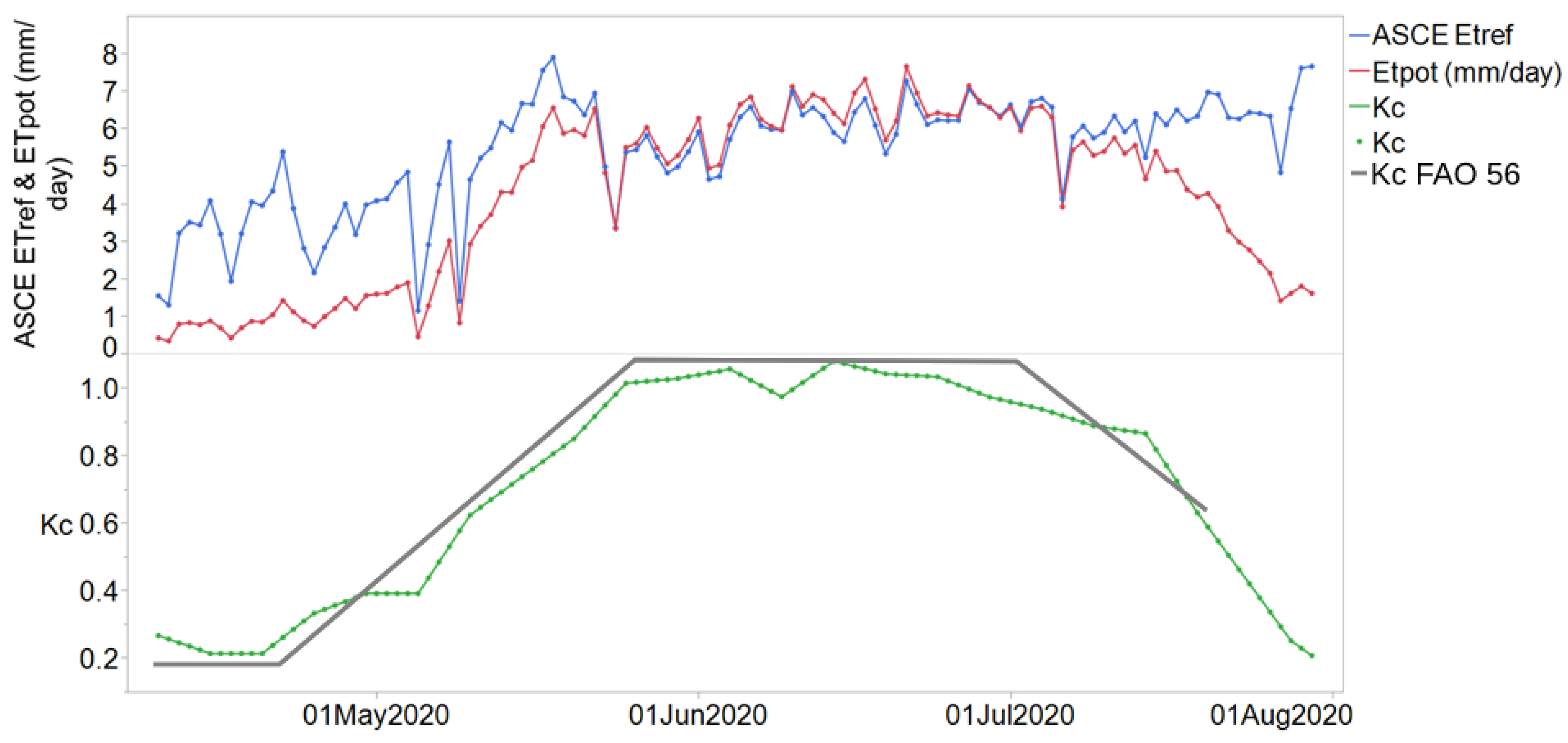

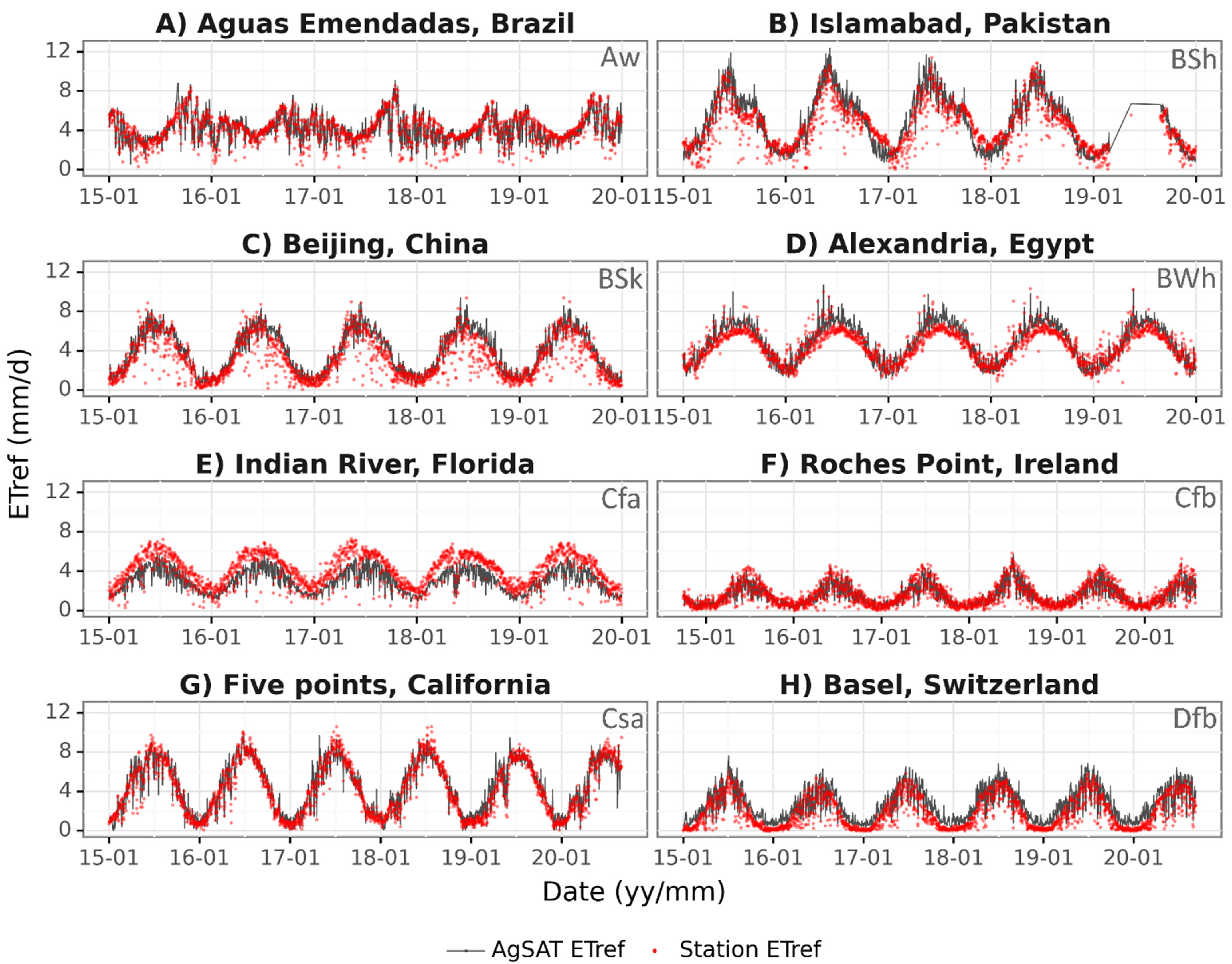
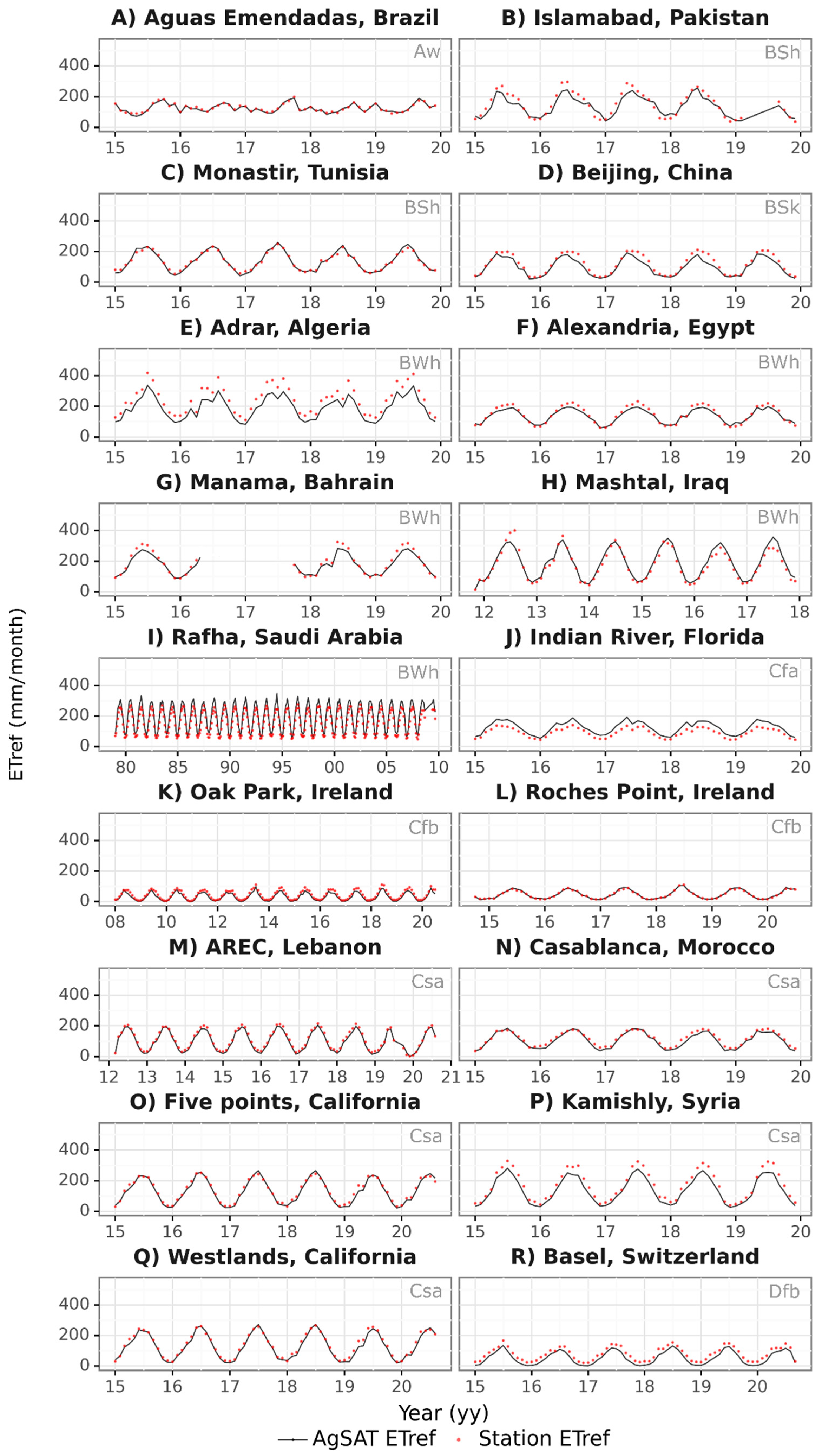
| Agrometeorological Data | Description | Unit |
|---|---|---|
| Temp | Temperature 2 m above ground | Kelvin |
| U-wind | U-component of wind 10 m above ground | m s−1 |
| V-wind | V-component of wind 10 m above ground | m s−1 |
| Rs | Downward short-wave radiation flux at surface, 6-hour average | W m−2 |
| RH_spec. | Specific humidity 2 m above ground | kg kg−1 |
| Pressure_surface | Pressure at surface | Pa |
| Irrigation System | Suggested Efficiency |
|---|---|
| Hand-move or portable or side roll | 70% |
| Traveling gun | 65% |
| Center and Linear move | 85% |
| Solid-set | 75% |
| Drip or bubbler | 85% |
| Micro-sprinkler | 80% |
| Surface | N/A |
| Location | Latitude | Longitude | Elevation (m) | Source | Climate | Period of Record |
|---|---|---|---|---|---|---|
| Aguas Emendadas, Brazil | 15°35′47″S | 47°37′32″W | 1030 | INMET | Aw | 2015–2019 |
| Monastir, Tunisia | 35°45′59″N | 10°49′59″E | 12 | Rp5 | BSh | 2015–2019 |
| Islamabad, Pakistan | 33°37′0″N | 73°6′0″E | 507 | Rp5 | BSh | 2015–2019 |
| Beijing, China | 39°56′59″N | 116°17′ 59″E | 57 | Rp5 | BSk | 2015–2019 |
| Manama, Bahrain | 26°12′59″N | 50°34′59″E | 8 | Rp5 | BWh | 2015–2019 |
| Adrar, Algeria | 27°50′0″N | 0°11′0″W | 280 | Rp5 | BWh | 2015–2019 |
| Alexandria, Egypt | 31°11′1″N | 29°56′56″E | −8 | Rp5 | BWh | 2015–2019 |
| Mashtal, Iraq | 33°19′18″N | 44°29′11″E | 39 | MOA, Iq | BWh | 2011–2017 |
| Rafha, Saudi Arabia | 29°37′33″N | 43°29′25″E | 448 | MOC, KSA | BWh | 1979–2009 |
| Indian River, Florida | 27°37′9″N | 80°34′21″W | 7 | FAWN | Cfa | 2015–2019 |
| Oak Park, Ireland | 52°51′38″N | 6°54’54″W | 62 | Met Éireann | Cfb | 2008–2020 |
| Roches Point, Ireland | 51°47′34″N | 8°14′38″W | 40 | Met Éireann | Cfb | 2014–2020 |
| Five Points, California | 36°20′10″N | 120°6′46″W | 87 | CIMIS | Csa | 2015–2020 |
| Westlands, California | 36°38′3″N | 120°22′54″W | 58 | CIMIS | Csa | 2015–2020 |
| Casablanca, Morocco | 33°34′0″N | 7°40′0″W | 52 | Rp5 | Csa | 2015–2019 |
| Kamishly, Syria | 37°1′59″N | 41°11′59″E | 447 | Rp5 | Csa | 2015–2019 |
| AREC, Lebanon | 33°55′31″N | 36°4′27″E | 993 | AUB | Csa | 2012–2020 |
| Basel, Switzerland | 47°32′48″N | 7°34′8″E | 284 | Meteoblue | Dfb | 2015–2020 |
Publisher’s Note: MDPI stays neutral with regard to jurisdictional claims in published maps and institutional affiliations. |
© 2022 by the authors. Licensee MDPI, Basel, Switzerland. This article is an open access article distributed under the terms and conditions of the Creative Commons Attribution (CC BY) license (https://creativecommons.org/licenses/by/4.0/).
Share and Cite
Jaafar, H.; Mourad, R.; Hazimeh, R.; Sujud, L. AgSAT: A Smart Irrigation Application for Field-Scale Daily Crop ET and Water Requirements Using Satellite Imagery. Remote Sens. 2022, 14, 5090. https://doi.org/10.3390/rs14205090
Jaafar H, Mourad R, Hazimeh R, Sujud L. AgSAT: A Smart Irrigation Application for Field-Scale Daily Crop ET and Water Requirements Using Satellite Imagery. Remote Sensing. 2022; 14(20):5090. https://doi.org/10.3390/rs14205090
Chicago/Turabian StyleJaafar, Hadi, Roya Mourad, Rim Hazimeh, and Lara Sujud. 2022. "AgSAT: A Smart Irrigation Application for Field-Scale Daily Crop ET and Water Requirements Using Satellite Imagery" Remote Sensing 14, no. 20: 5090. https://doi.org/10.3390/rs14205090
APA StyleJaafar, H., Mourad, R., Hazimeh, R., & Sujud, L. (2022). AgSAT: A Smart Irrigation Application for Field-Scale Daily Crop ET and Water Requirements Using Satellite Imagery. Remote Sensing, 14(20), 5090. https://doi.org/10.3390/rs14205090











